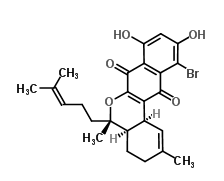
Urauchimycins are antimycin antibiotics isolated from marine actinomycete. [1]

Urauchimycins are antimycin antibiotics isolated from marine actinomycete. [1]

The Actinomycetota are a diverse phylum of Gram-positive bacteria with high G+C content. They can be terrestrial or aquatic. They are of great economic importance to humans because agriculture and forests depend on their contributions to soil systems. In soil they help to decompose the organic matter of dead organisms so the molecules can be taken up anew by plants. While this role is also played by fungi, Actinomycetota are much smaller and likely do not occupy the same ecological niche. In this role the colonies often grow extensive mycelia, like a fungus would, and the name of an important order of the phylum, Actinomycetales, reflects that they were long believed to be fungi. Some soil actinomycetota live symbiotically with the plants whose roots pervade the soil, fixing nitrogen for the plants in exchange for access to some of the plant's saccharides. Other species, such as many members of the genus Mycobacterium, are important pathogens.

Streptomyces is the largest genus of Actinomycetota, and the type genus of the family Streptomycetaceae. Over 700 species of Streptomyces bacteria have been described. As with the other Actinomycetota, streptomycetes are gram-positive, and have very large genomes with high GC content. Found predominantly in soil and decaying vegetation, most streptomycetes produce spores, and are noted for their distinct "earthy" odor that results from production of a volatile metabolite, geosmin. Different strains of the same species may colonize very diverse environments.
Antimycins are produced as secondary metabolites by Streptomyces bacteria, a soil bacteria. These specialized metabolites likely function to kill neighboring organisms in order to provide the streptomyces bacteria with a competitive edge.

The Actinomycetales is an order of Actinomycetota. A member of the order is often called an actinomycete. Actinomycetales are generally gram-positive and anaerobic and have mycelia in a filamentous and branching growth pattern. Some actinomycetes can form rod- or coccoid-shaped forms, while others can form spores on aerial hyphae. Actinomycetales bacteria can be infected by bacteriophages, which are called actinophages. Actinomycetales can range from harmless bacteria to pathogens with resistance to antibiotics.

Cephems are a sub-group of β-lactam antibiotics including cephalosporins and cephamycins. It is one of the most common 4-membered ring heterocycle. Produced by actinomycetes, cephamycins were found to display antibacterial activity against a wide range of bacteria, including those resistant to penicillin and cephalosporins. The antimicrobial properties of Cephem include the attachment to certain penicillin-binding proteins that are involved in the production of cell walls of bacteria.

Streptomycetaceae is a family of Actinomycetota, making up the monotypic order Streptomycetales. It includes the important genus Streptomyces. This was the original source of many antibiotics, namely streptomycin, the first antibiotic against tuberculosis.
Streptomyces spectabilis is a bacterium species from the genus of Streptomyces. Streptomyces spectabilis produces hangtaimycin, gentamicin, kanamycin, neomycin B, sisomycin, tobramycin, paromomycin, spectinabilin, spectinomycin, aminocyclitol, actinospectacin, prodigiosine and the streptovaricin complex.

Nocardicin A is a monocyclic β-lactam antibiotic included in the monobactam subclass. It is obtained from the fermentation broth of a strain of actinomycetes Nocardia uniformis subsp. tsuyamenensis as a metabolic product catalyzed by the enzyme nocardicin-A epimerase. It is stereochemically and biologically related to penicillin and cephalosporins.

Anthracimycin is a polyketide antibiotic discovered in 2013. Anthracimycin is derived from marine actinobacteria. In preliminary laboratory research, it has shown activity against Bacillus anthracis, the bacteria that causes anthrax, and against methicillin-resistant Staphylococcus aureus (MRSA).
Streptomonospora alba is a halophilic species of bacteria. YIM 90003(T) is the type strain. It is closest to Streptomonospora salina. Its genome sequence was reported in 2015.

Etamycin, also known as viridogrisein, is a cyclic peptide antibiotic isolate of marine actinomycete. Etamycin was first isolated from a Streptomyces species in 1957 by Lawson and co-workers.

Altemicidin is monoterpene alkaloid first identified in isolates from marine actinomycetes in 1989. It may also be produced synthetically. Altemicidin displays both acaricidal and antitumor activity.

Marinone is an antibiotic made by marine actinomycetes.

Salinispora is a genus of obligately aerobic, gram-positive, non-acid-fast bacteria belonging to the family of Micromonosporaceae. They are heterotrophic, non-motile, and obligately grow under high osmotic/ionic-strength conditions. They are the first identified genus of gram-positive bacteria which has a high osmotic/ionic-strength requirement for survival. They are widely abundant in tropical marine sediments and were first identified in 2002. This genus of bacteria has potential biotechnological significance due to their production of novel secondary metabolites which can be used pharmaceutically.

Streptomyces antibioticus is a gram-positive bacterium discovered in 1941 by Nobel-prize-winner Selman Waksman and H. Boyd Woodruff. Its name is derived from the Greek "strepto-" meaning "twisted", alluding to this genus' chain-like spore production, and "antibioticus", referring to this species' extensive antibiotic production. Upon its first characterization, it was noted that S. antibioticus produces a distinct soil odor.
Streptomyces afghaniensis is a bacterium species from the genus of Streptomyces which has been isolated from soil in Afghanistan. Streptomyces afghaniensis produces the antibiotic taitomycin.
Streptomyces aurantiogriseus is a bacterium species from the genus Streptomyces which has been isolated from soil in Russia. Streptomyces aurantiogriseus produces differolide and acetamidobenzoic acid.
Streptomyces lavendulae is a species of bacteria from the genus Streptomyces. It is isolated from soils globally and is known for its production of medically useful biologically active metabolites. To see a photo of this organism click here.
Streptomyces lusitanus is a bacterium species from the genus of Streptomyces which has been isolated from soil. Streptomyces lusitanus produces 7-chlortetracycline, naphthyridinomycin, cyanocycline B, N-desmethylnaphthyridinomycin and tetracycline.

Thiocoraline is a microbial natural product of the depsipeptide class. Thiocoraline was isolated from the mycelium cake of a marine actinomycete strain L-13-ACM2-092. In vitro, thiocoraline causes an arrest in G1 phase of the cell cycle and decreases the rate of S phase progression towards G2/M phase. Thiocoraline is likely to be a DNA replication inhibitor. Thiocoraline is produced on a nonribosomal peptide synthetase (NRPS) assembly line.
![]() Media related to Urauchimycins at Wikimedia Commons
Media related to Urauchimycins at Wikimedia Commons